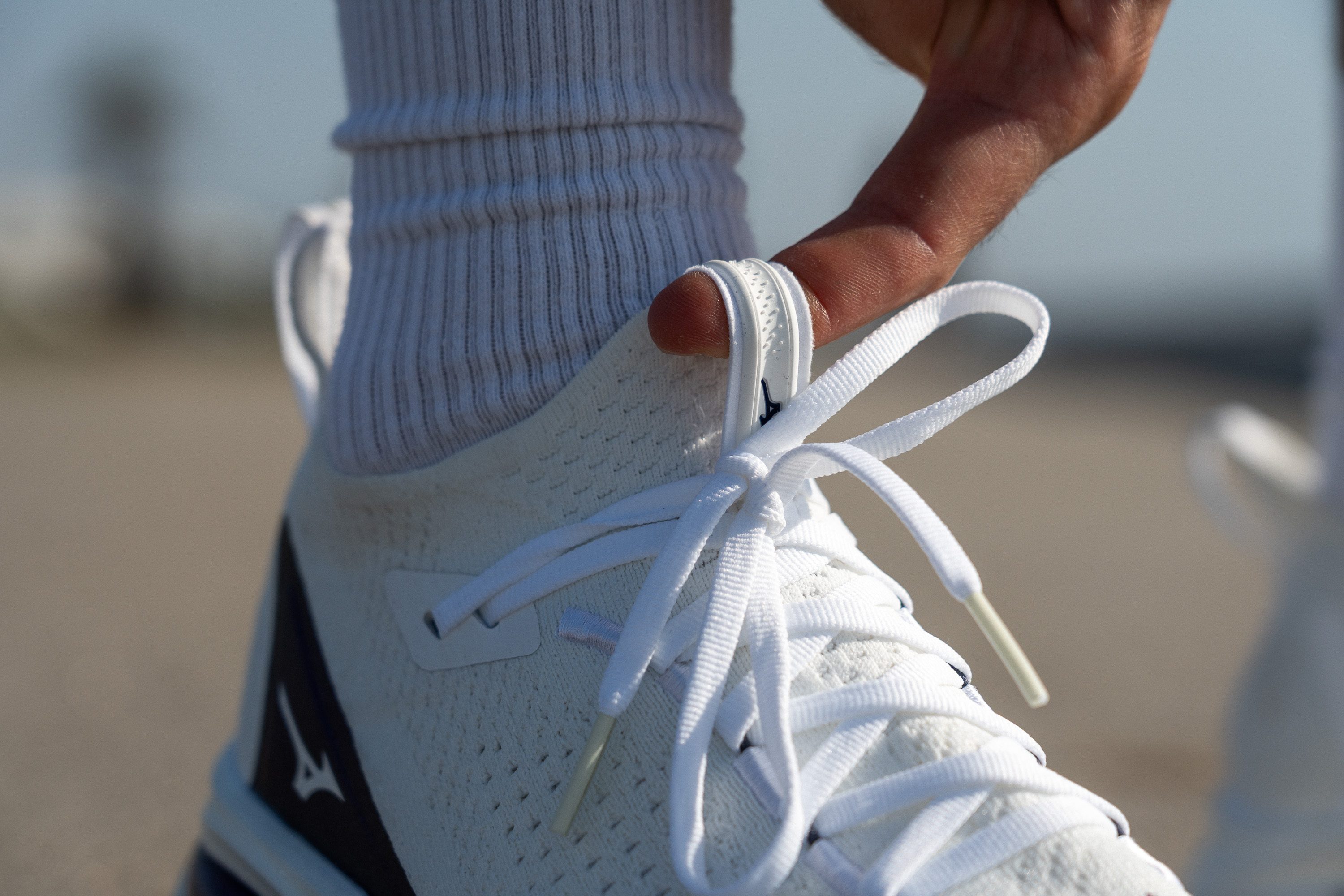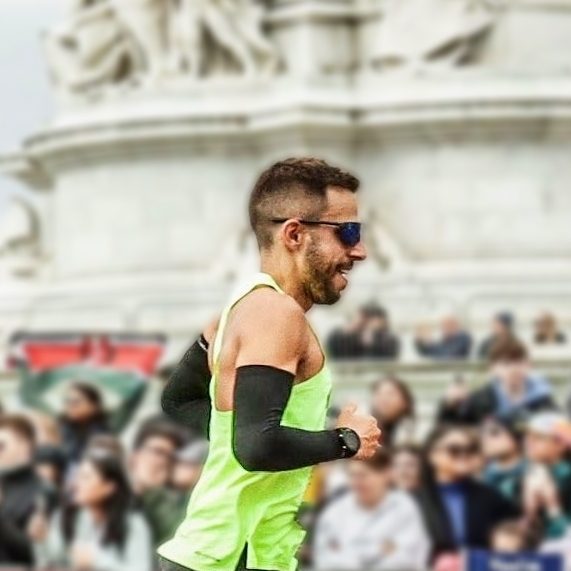Our verdict
- Top pick in best running shoes
- Top pick in best long distance running shoes
Pros
- Massive stack height
- Super-plush Enerzy NXT foam
- Perfect for long runs
- Lightweight for its huge size
- Good durability
- Breathable knit upper
- Roomy toebox height
- Insanely fun!
Cons
- Not enough energy return
- Price hike feels unjustified
- Not stable for heel strikers
Audience verdict
- Top 18% most popular running shoes
Comparison
The most similar running shoes compared
+ + Add a shoe | |||||
|---|---|---|---|---|---|
| Audience score | 83 Good! | 91 Superb! | 88 Great! | 85 Good! | |
| Price | $200 | $170 | $240 | $150 | |
| Pace | Daily runningTempo | Daily running | Daily running | Daily running | |
| Shock absorption | High | High | High | High | |
| Energy return | Moderate | Moderate | Low | Low | |
| Traction | High | Moderate | High | High | |
| Arch support | Neutral | Neutral | Neutral | Neutral | |
| Weight lab Weight brand | 9.3 oz / 264g 9.4 oz / 266g | 9.6 oz / 271g 9.8 oz / 277g | 9.5 oz / 268g 9.7 oz / 275g | 9.1 oz / 258g 9.3 oz / 265g | |
| Drop lab Drop brand | 8.5 mm 8.0 mm | 10.0 mm 8.0 mm | 7.8 mm 6.0 mm | 8.3 mm 10.0 mm | |
| Strike pattern | HeelMid/forefoot | HeelMid/forefoot | Mid/forefoot | HeelMid/forefoot | |
| Size | Half size large | True to size | - | - | |
| Midsole softness | Soft | Soft | Soft | Soft | |
| Difference in midsole softness in cold | Small | Normal | Normal | Normal | |
| Toebox durability | Good | Good | Decent | Decent | |
| Heel padding durability | Good | Good | Bad | Good | |
| Outsole durability | Good | Bad | Good | Decent | |
| Breathability | Moderate | Moderate | Moderate | Moderate | |
| Width / fit | Medium | Medium | Narrow | Medium | |
| Toebox width | Medium | Medium | Narrow | Wide | |
| Stiffness | Moderate | Moderate | Moderate | Moderate | |
| Torsional rigidity | Stiff | Moderate | Stiff | Stiff | |
| Heel counter stiffness | Flexible | Moderate | Stiff | Stiff | |
| Rocker | ✓ | ✗ | ✓ | ✗ | |
| Heel lab Heel brand | 46.0 mm 44.5 mm | 40.7 mm 42.0 mm | 39.9 mm 40.0 mm | 37.5 mm 39.0 mm | |
| Forefoot lab Forefoot brand | 37.5 mm 36.5 mm | 30.7 mm 34.0 mm | 32.1 mm 34.0 mm | 29.2 mm 29.0 mm | |
| Widths available | NormalWide | NormalWide | Normal | NormalWide | |
| Orthotic friendly | ✓ | ✓ | ✓ | ✓ | |
| Season | All seasons | All seasons | All seasons | All seasons | |
| Removable insole | ✓ | ✓ | ✓ | ✓ | |
| Ranking | #274 Bottom 26% | #25 Top 7% | #121 Top 33% | #221 Bottom 41% | |
| Popularity | #65 Top 18% | #207 Bottom 44% | #306 Bottom 18% | #130 Top 35% |
Who should buy
After a successful first generation, the Neo Vista 2 aims to keep the momentum going. And we think it’s a top pick for:
- Those who want maximum shock absorption to reduce impact forces on the body.
- Neutral runners seeking a long-run shoe with cloud-soft cushioning.
- Fans of knit uppers looking for a supertrainer versatile enough for daily miles.
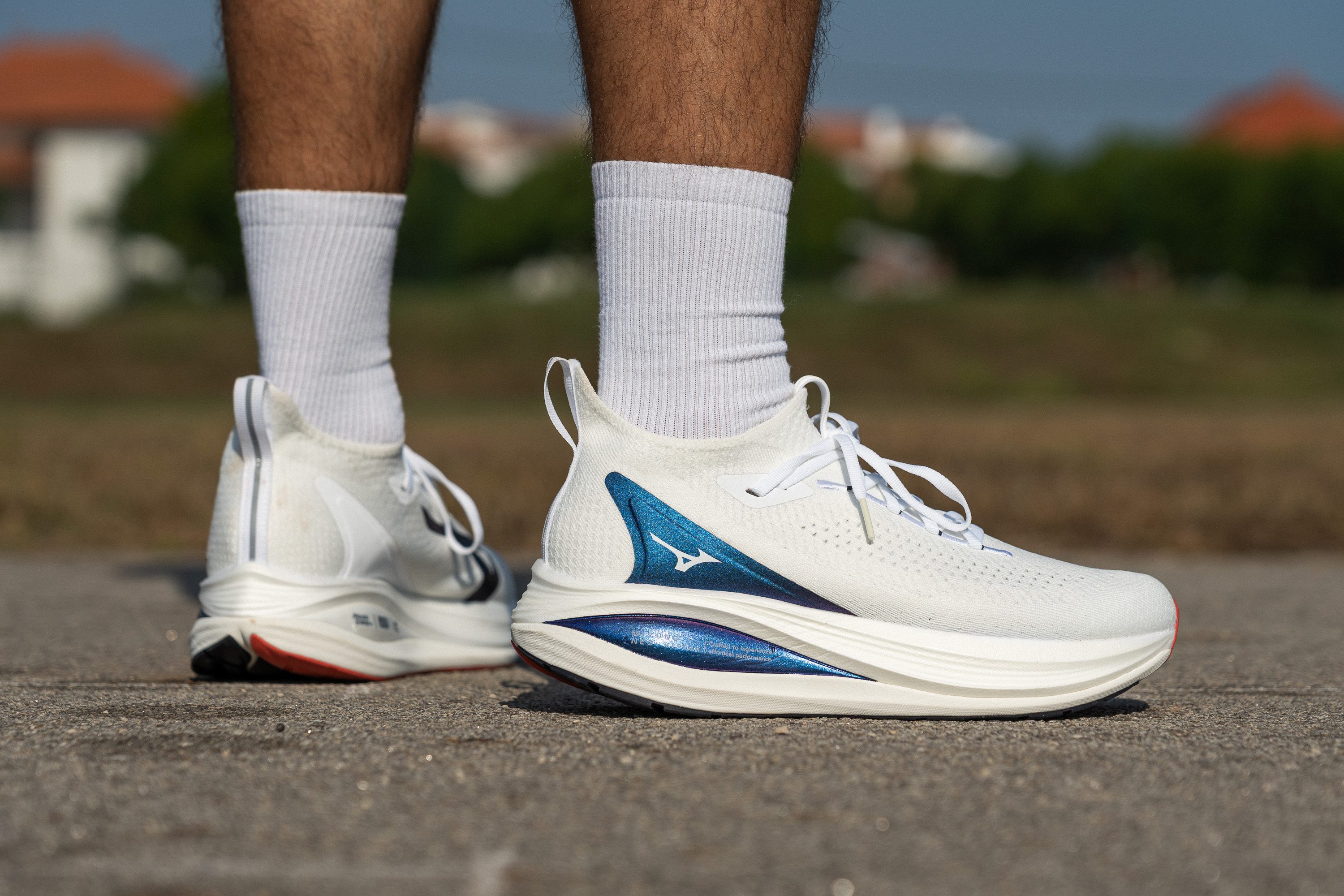
Who should NOT buy
We believe that the Neo Vista 2 doesn’t deliver enough energy return for its high price tag. It may feel bouncy due to its soft foam, but our lab data tells a different story. For performance-oriented runners, we think the Saucony Endorphin Speed 5 or Adidas Adizero EVO SL offer a more interesting ride... and they’re also easier on your wallet.
We’re also convinced that the price hike from v1 may push away some runners. If you want plush comfort without overspending, we suggest looking into the ASICS Novablast 5 or Mizuno’s own Neo Zen.
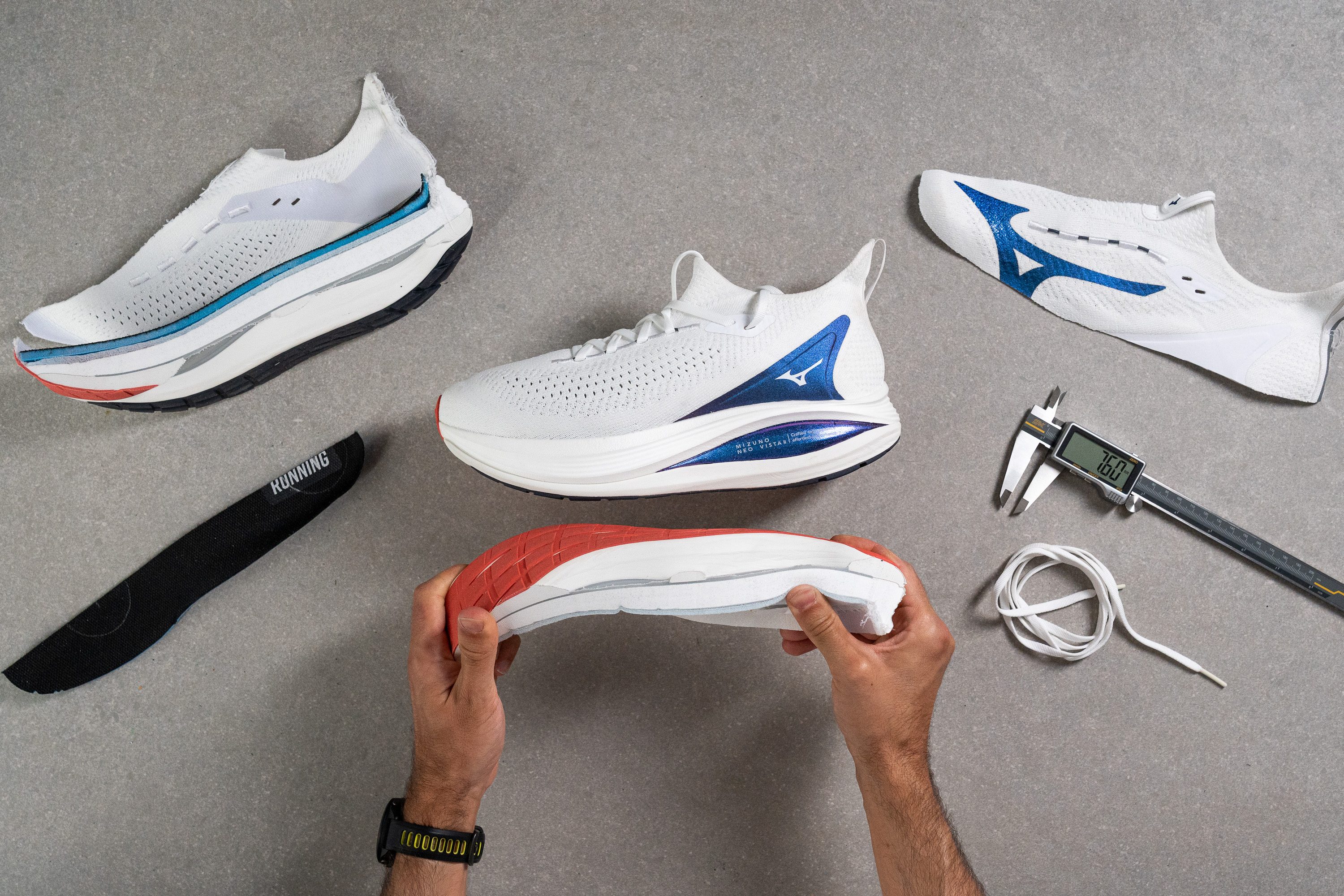
Cushioning
Shock absorption
At the time of this review, the first generation of the Mizuno Neo Vista was the shoe that recorded the highest shock absorption result with 163 SA, outperforming more than 200 other models—including ultra-plush supertrainers and tank-like shoes such as the Adidas Adizero Prime X3 STRUNG.
But Mizuno didn't stop there. With 170 SA in the heel and 137 SA in the forefoot, version 2 returns stronger with a pillow-soft ride and takes the lead until another shoe steals the crown, a task that won't be easy. The shock absorption of this shoe is absolutely phenomenal.

| Neo Vista 2 | 170 SA |
| Average | 129 SA |
Energy return
Energy return also improves from its predecessor, and this was very important since it was the biggest letdown we discovered in that shoe. However, 60.3% of bounce still feels underwhelming, especially for a shoe that received a noticeable price hike in this update.
That said, the shoe feels surprisingly lively because of its deep stack and marshmallow-like foam, and that’s exactly why it's so important to test it in the lab.
| Neo Vista 2 | 60.3% |
| Average | 58.5% |
Heel stack
The Neo Vista 2 seems to bring a bit more of everything compared to its predecessor, and the heel stack follows this trend. We measured an increase from 44.9 mm to 46.0 mm, making it (again) one of the tallest road shoes ever made.

And remember that we measure stack height at the official World Athletics points, but due to the curved rocker of the Neo Vista 2, there’s extra thickness around the midfoot. All in all, if you’re after a maximalist running shoe, truth is that few can match this one no matter your footstrike.

| Neo Vista 2 | 46.0 mm |
| Average | 34.8 mm |
Forefoot stack
The forefoot is also stacked as hell with 37.5 mm of foam. Think about it—the forefoot stack alone is higher than the average heel stack in our lab.
That’s how towering it is. Therefore, even with its super-soft foam, this shoe guarantees zero ground feel and excellent impact dampening. It’s basically like running on clouds, with all the pros and cons that come with it.
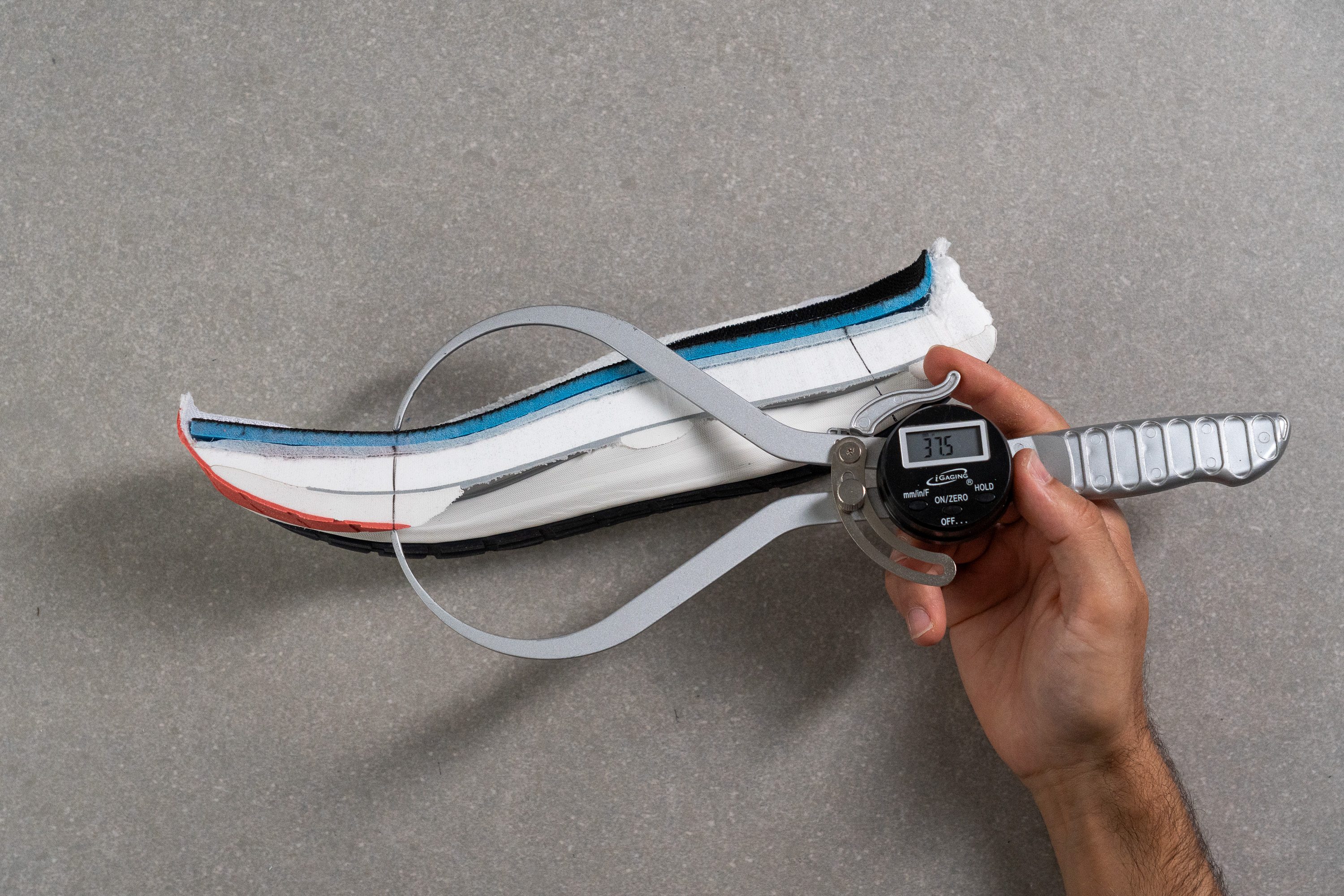
| Neo Vista 2 | 37.5 mm |
| Average | 26.2 mm |
Drop
The official drop from the Neo Vista is 8 mm, and we measured 8.5 mm—an acceptable difference that’s easily explained by manufacturing tolerances.
However, there’s a catch with this shoe. With such a towering stack and marshmallowy-soft foam, the so-called "dynamic drop" felt while running can seem lower than 8.5 mm for heel strikers, since the deep-sinking compression in the rear creates the sensation of a lower drop.
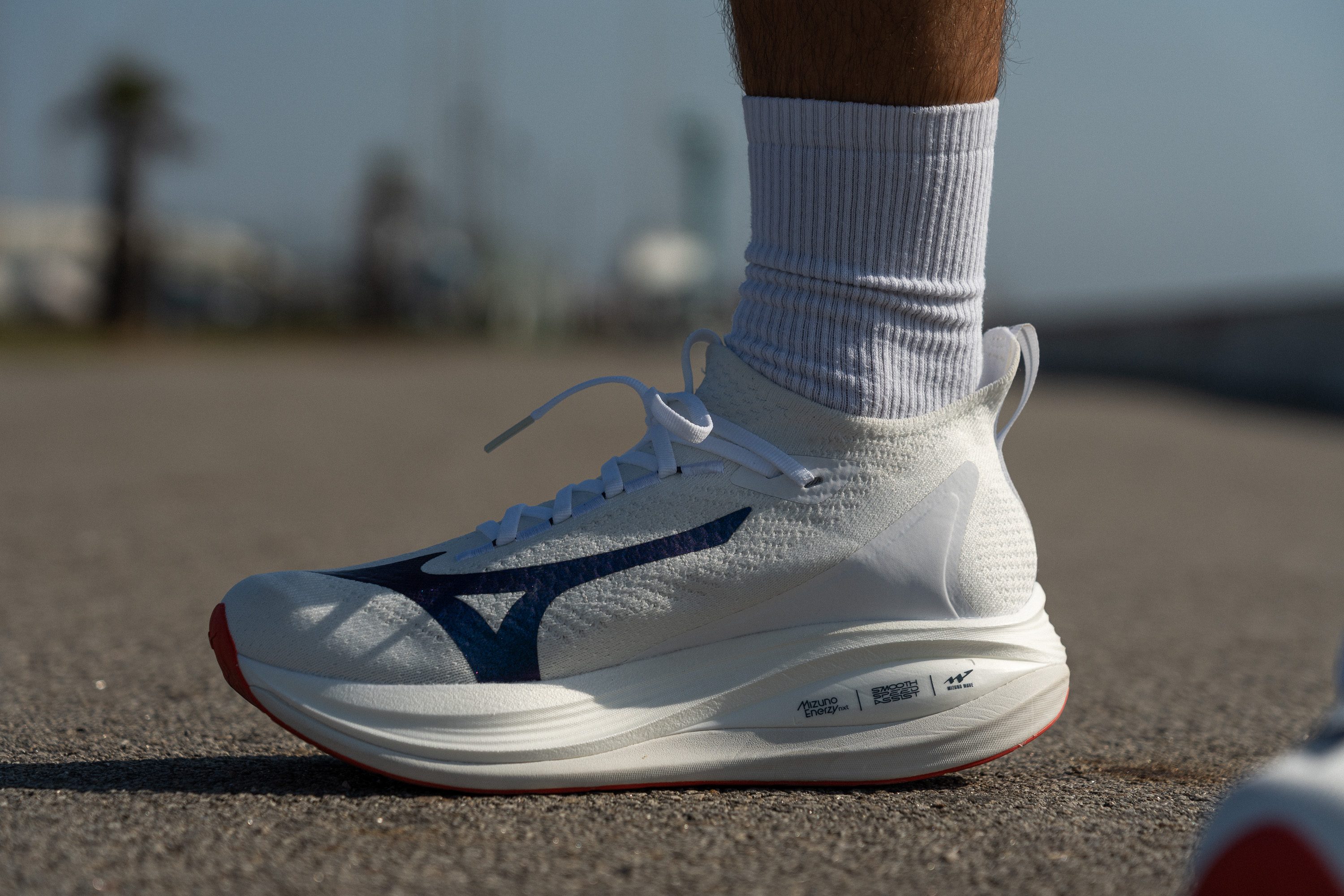
| Neo Vista 2 | 8.5 mm |
| Average | 8.6 mm |
Midsole softness
We already mentioned the ultra-soft foam of the Neo Vista 2, and that’s for a good reason. But let’s start from the beginning.
This shoe features a dual-density Enerzy NXT midsole, with the top layer switching from EVA to TPU to boost energy return. It’s a positive upgrade overall, although we think that going for PEBA here would've been ideal. But if you’re chasing pillow-soft comfort, this foam delivers as it clocks a ridiculously low 10.0 HA in our durometer test.

| Neo Vista 2 | 10.0 HA |
| Average | 20.4 HA |
Secondary foam softness
The secondary layer is the one made from EVA, and it's the main reason this shoe sticks to an average energy return. It’s also much firmer—measuring 20.0 HA—to provide added stability and extra durability.
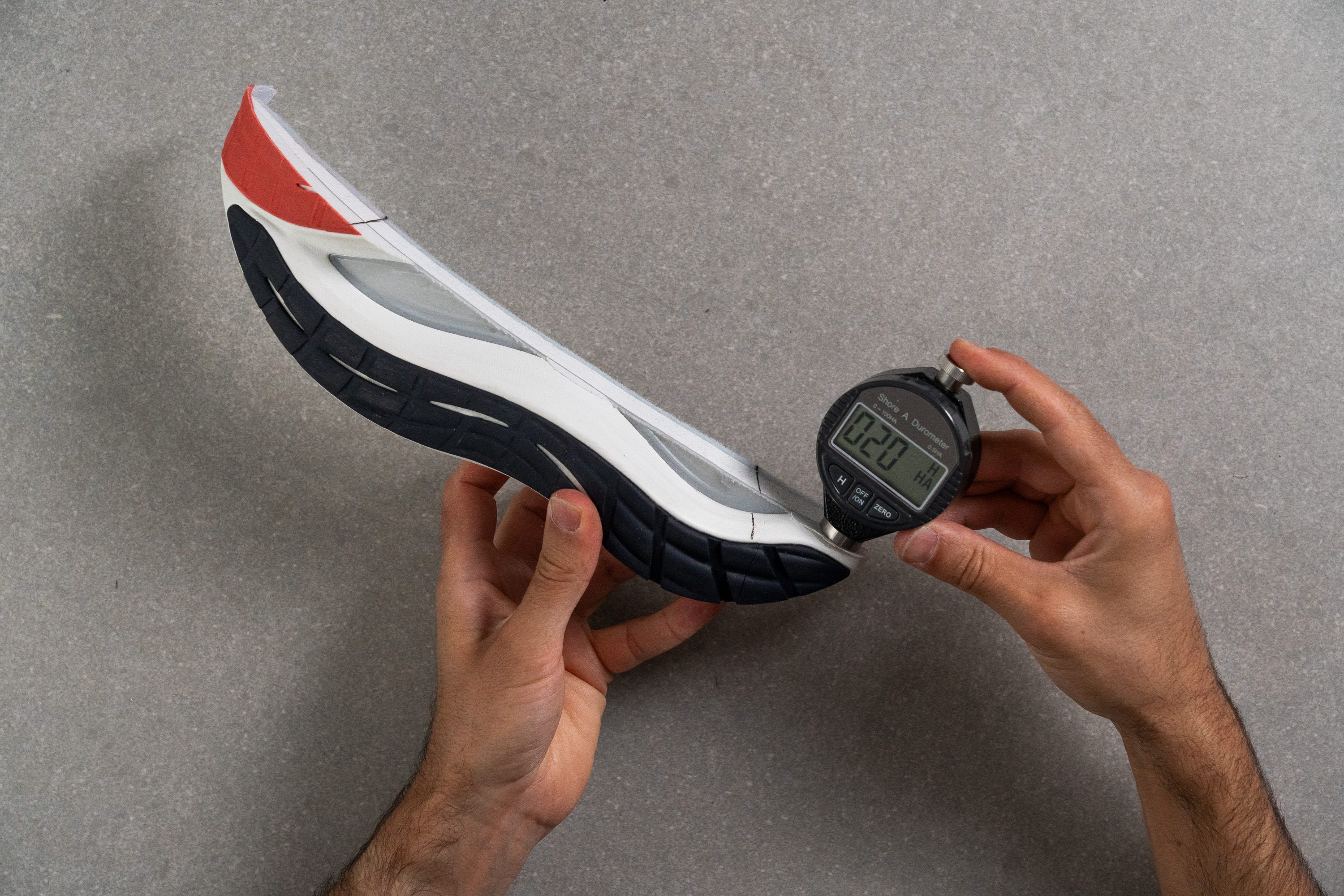
| Neo Vista 2 | 20.0 HA |
| Average | 22.7 HA |
Rocker
The Mizuno Neo Vista 2 features a rockered geometry that’s essential given its towering stack height of 46.0 mm in the heel and 37.5 mm in the forefoot. The rocker starts at 8 cm in the forefoot and it's very gradual, creating a smooth-rolling feel that helps offset the shoe’s ultra-soft foam.
We also found a pronounced heel bevel, which is crucial for helping heel strikers enjoy a better experience. The combination of plush cushioning and sky-high heel stack can otherwise lead to sluggish transitions.
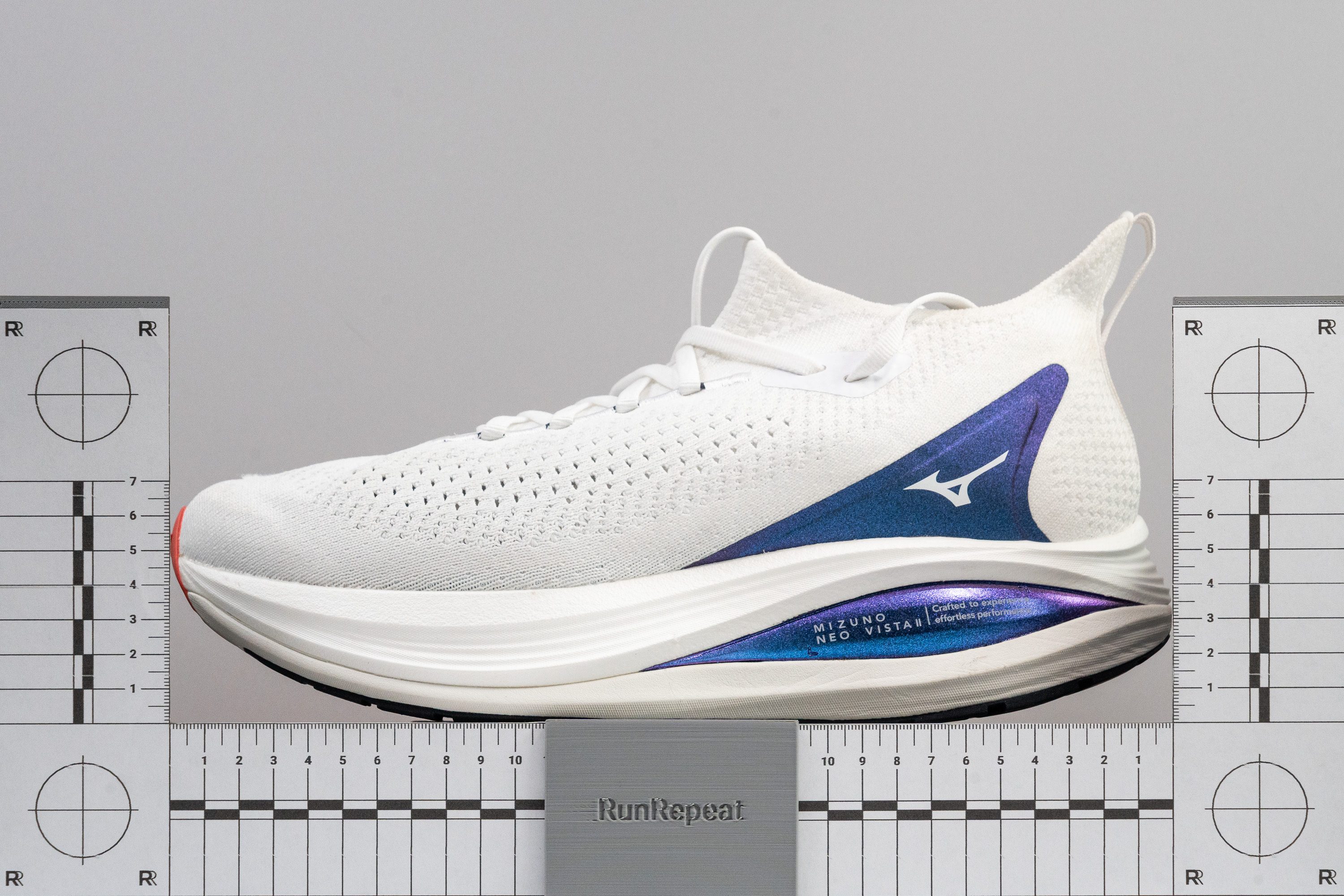
Plate
We found again the same fiberglass Wave Plate that worked so well in the first Neo Vista. It's essential for stabilizing the foot on every landing and adding a touch of pop, but don’t expect a carbon-like feel though, as this plate doesn’t bring much stiffness.
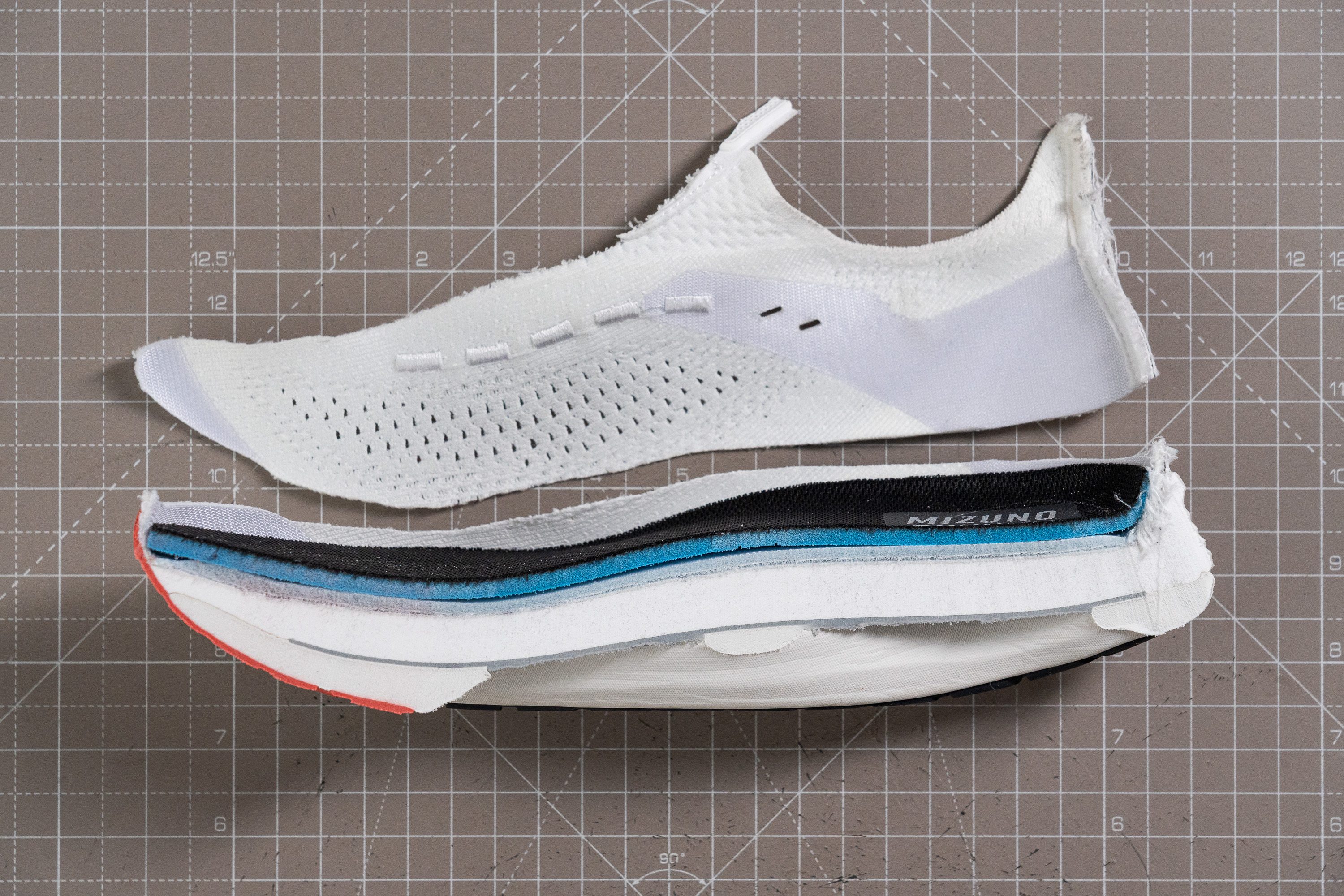
Size and fit
Size
Mizuno Neo Vista 2 fits half size large (59 votes).
Consider sizing down
Width / Fit
The fit of the Neo Vista 2 is a very interesting topic, because knit uppers can sometimes be deceiving due to their stretchiness, often offering more room than they appear to. But in the Neo Vista 2, the upper isn’t very stretchy, and it behaves just like a standard mesh.
The widest part measured 96.5 mm, which points to an average fit with just a bit more room than what you’d usually find in a daily trainer.
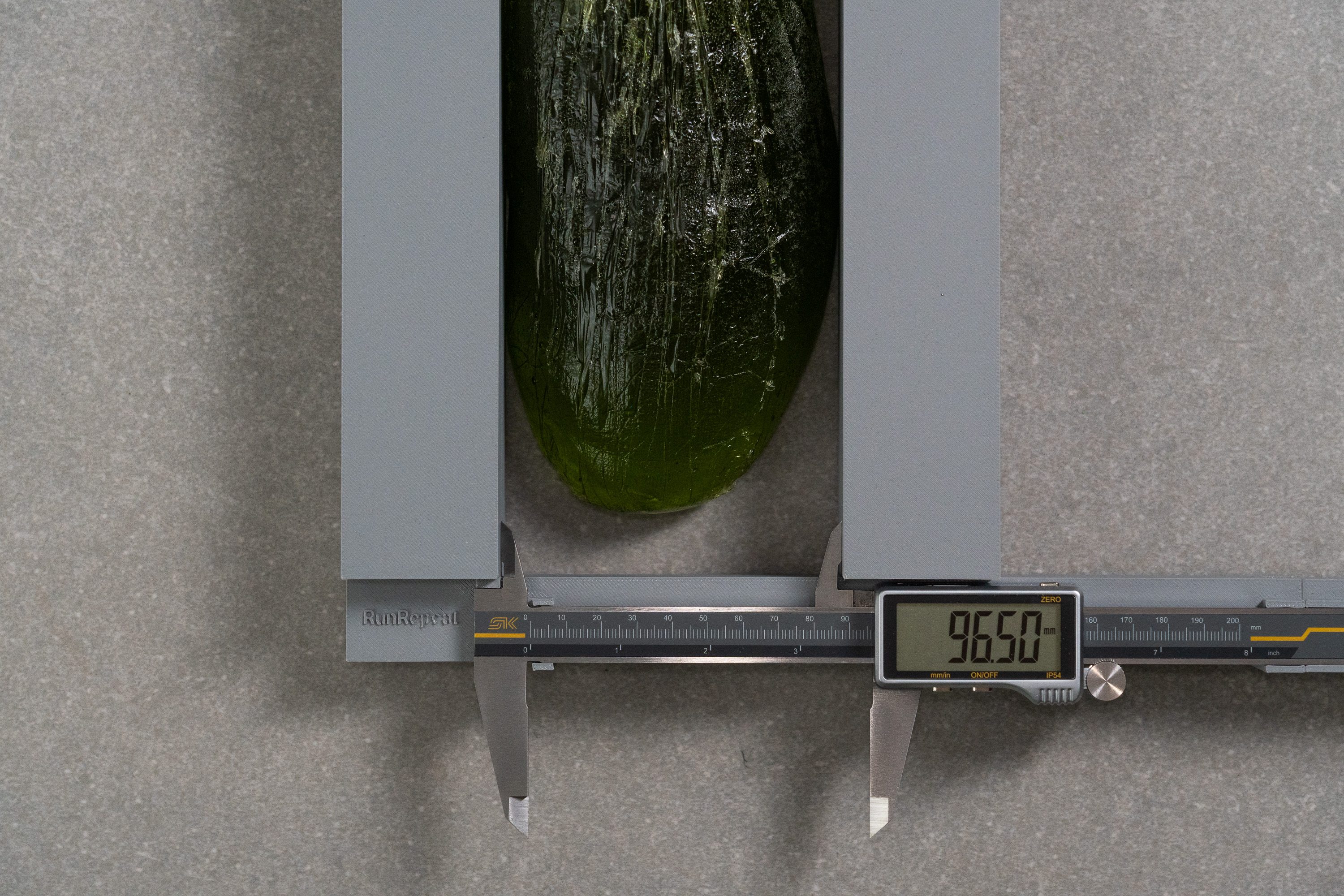
| Neo Vista 2 | 96.5 mm |
| Average | 95.1 mm |
Toebox width
The toebox now measures 72.9 mm, making it more tapered than the 74.6 mm we found in version 1. And while it’s true that the knit has some give on the toes thanks to the lack of reinforcements or seams, don’t expect a wide-foot-friendly shoe.
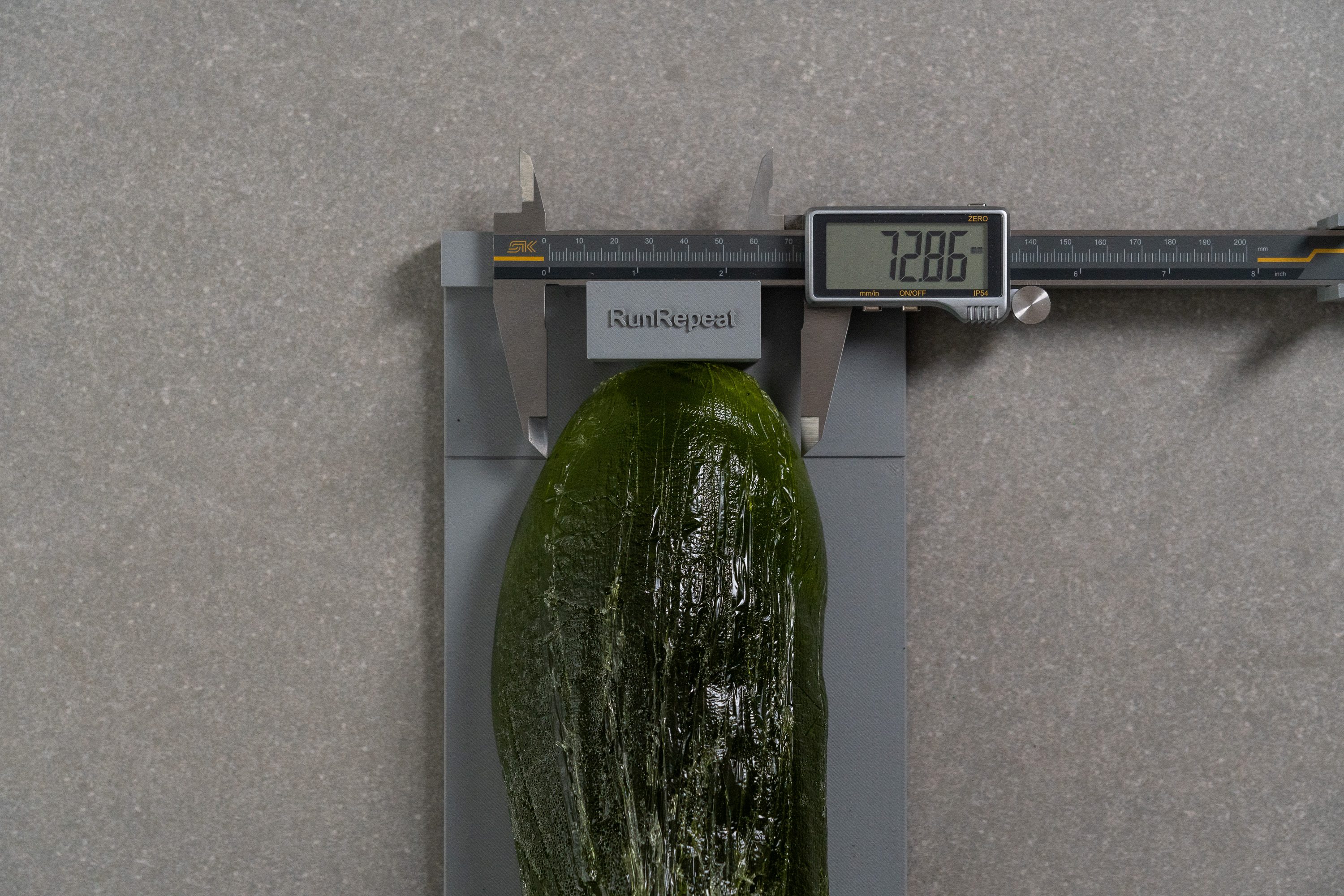
| Neo Vista 2 | 72.9 mm |
| Average | 73.2 mm |
Toebox height
In contrast, there’s plenty of room for the toes with 29.2 mm of vertical clearance. It’s ideal for runners who dislike toe pressure, though those who prefer a snug-and-secure fit might find the Neo Vista 2 a bit baggy.
If you had version 1, it registered only 25.7 mm in the same area—making this a noticeable, comfort-focused update.

| Neo Vista 2 | 29.2 mm |
| Average | 27.1 mm |
Traction / Grip
Traction test
Mizuno used its X10 rubber in the Neo Vista 2 as part of the updates for this second version, and it brought a slight improvement in grip. It now reaches 0.45 in our wet concrete test, a solid result that confirms good traction in both dry and wet conditions, although at $200 we expected a bit more.
| Neo Vista 2 | 0.45 |
| Average | 0.48 |
Outsole design
The outsole of the Mizuno Neo Vista 2 features red and black X10 rubber segments that fully cover the forefoot, midfoot and heel. These zones are separated by a massive cutout running through the center, which helps reduce weight and increase flexibility in this area.
A key design update is the midfoot cutout, now split into two separate windows instead of one.
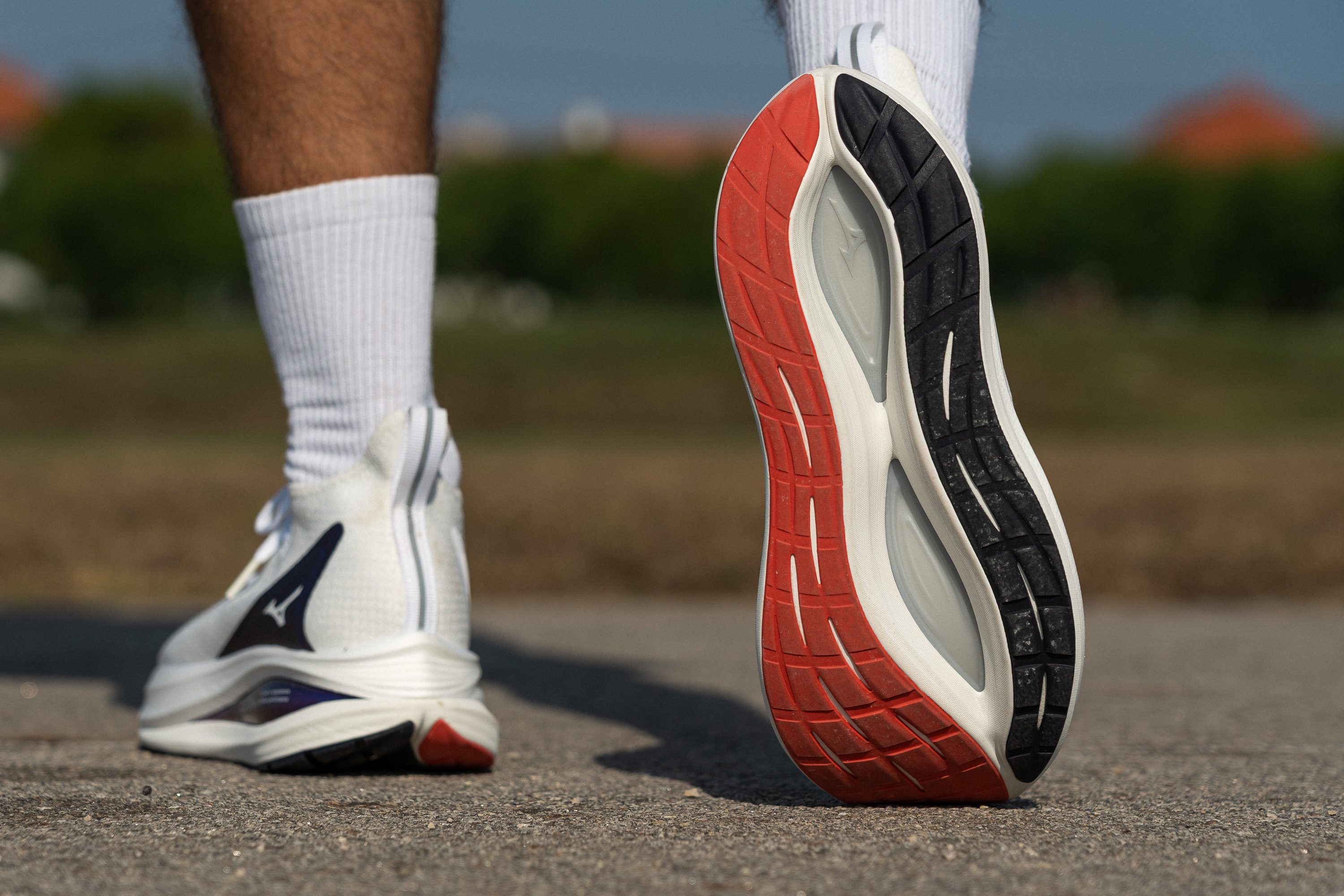
Flexibility / Stiffness
We really like that Mizuno stuck with a fiberglass plate instead of switching to carbon, which would’ve ruined the comfort for daily runs. In fact, it scored below average in our 30-degree bend test with just 13.5N.

| Neo Vista 2 | 13.5N |
| Average | 15.3N |
Weight
There’s a minor jump in weight from v1 (9.1 oz or 259g) to v2 (9.3 oz or 264g). However, it’s so small that it’s impossible to notice, and it’s justified by the increased stack height and thicker outsole. Plus, it’s still a great result for such a high-stack, max-cushion running shoe.
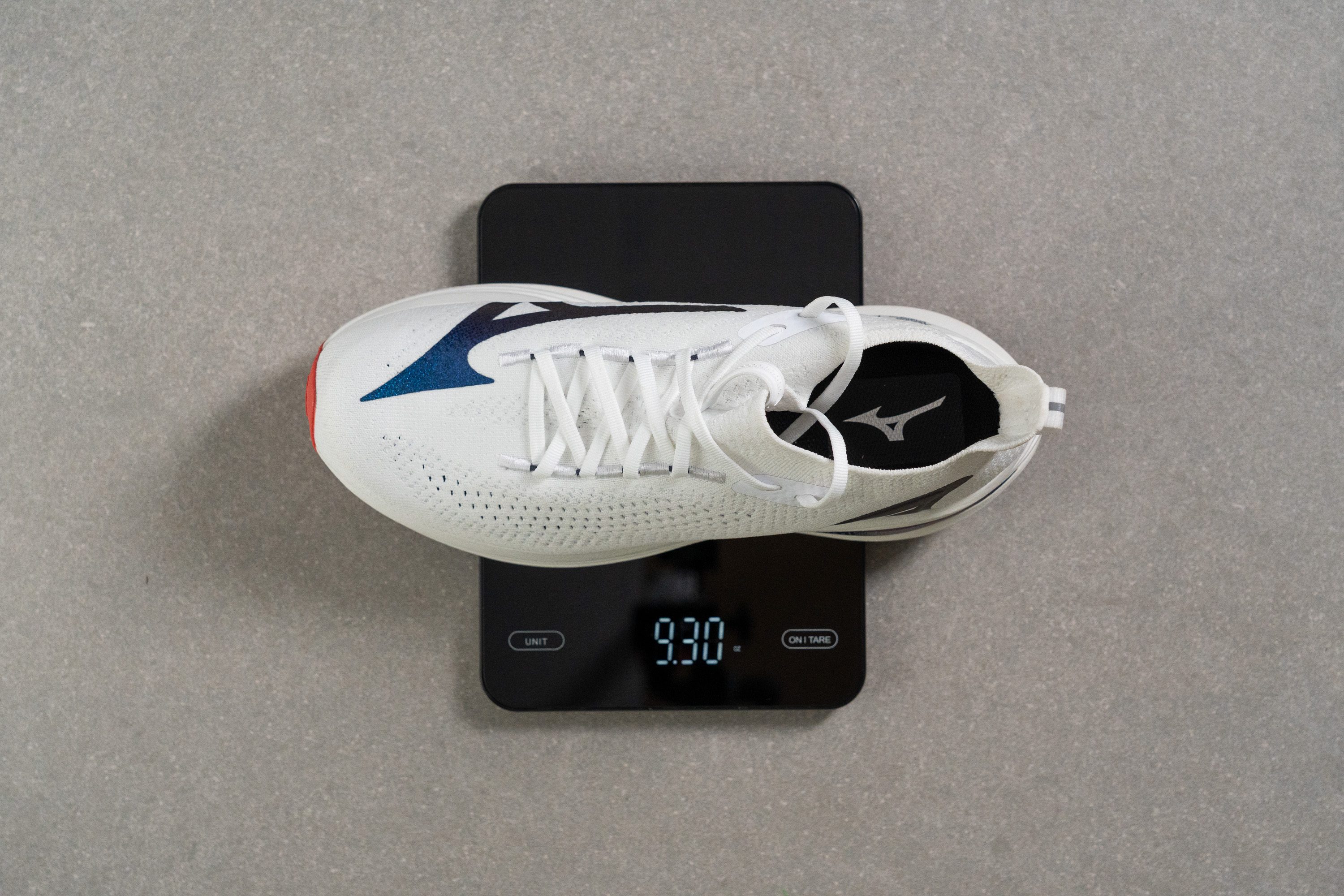
| Neo Vista 2 | 9.3 oz (264g) |
| Average | 9.3 oz (264g) |
Breathability
The OG Neo Vista was a solid shoe that left almost everyone pleased, but those running in hot summers weren’t as happy. The knit-based upper was too dense and lacked proper ventilation.
Thankfully, Mizuno brought the design from the Neo Zen to this shoe, fixing breathability. It now scores 4 out of 5 in our test, making it suitable for any season or temperature.
It’s easy to understand why ventilation has improved. The one-piece knit upper now features dozens of ventilation holes, helping to lower the temperature inside the shoe.

The knit is still thick and protective, as we confirmed under the microscope. This highlights how essential the ventilation holes are to help the shoe expel heat effectively.
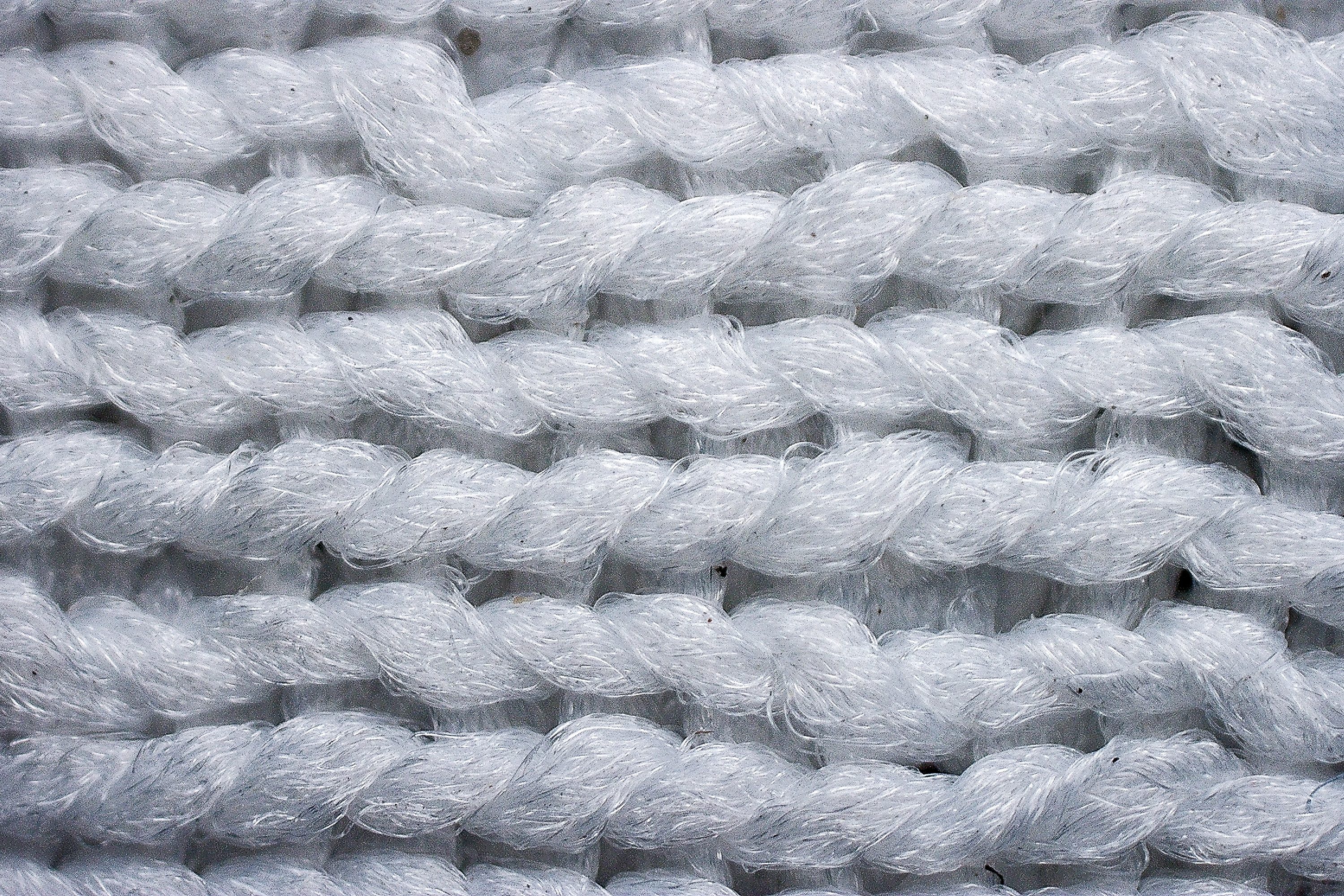
We think the upper is a blessing for runners who enjoy knit-based shoes and dislike seams. It’s simple yet effective, and the materials Mizuno uses feel reliable and aligned with the shoe’s price.
| Neo Vista 2 | 4 |
| Average | 3.7 |
Stability
Lateral stability test
The Neo Vista 2 is a neutral running shoe, and we don’t recommend it for runners looking for stability in a supertrainer. Instead, the ASICS Superblast 2 is a better option.
The NV2 is too soft for those with pronation issues and only provides a smooth ride when landing in a straight line. In fact, taking corners carries some risk—even with those TPU reinforcements around the sides of the heel.
Torsional rigidity
The nylon-based Wave Plate plays a key role in giving the shoe a rigid feel. It boosts torsional rigidity to a strong 4/5 in our test.
| Neo Vista 2 | 4 |
| Average | 3.5 |
Heel counter stiffness
The heel scores just 1 out of 5. Like many sock-like knit uppers, it lacks any real structure—so runners needing extra stability in this area might prefer a more traditional design.
On the flip side, it’s ultra-comfortable and a great choice for those with Achilles sensitivity.
| Neo Vista 2 | 1 |
| Average | 2.9 |
Midsole width - forefoot
We were surprised to see that Mizuno reduced the forefoot midsole width from 120.8 mm to 116.4 mm.
It’s not a bad move, it definitely creates a more nimble ride that's great for fast paces. We also noticed the change comes mainly from a narrower central cutout compared to version 1, which clearly reshapes the underfoot platform.
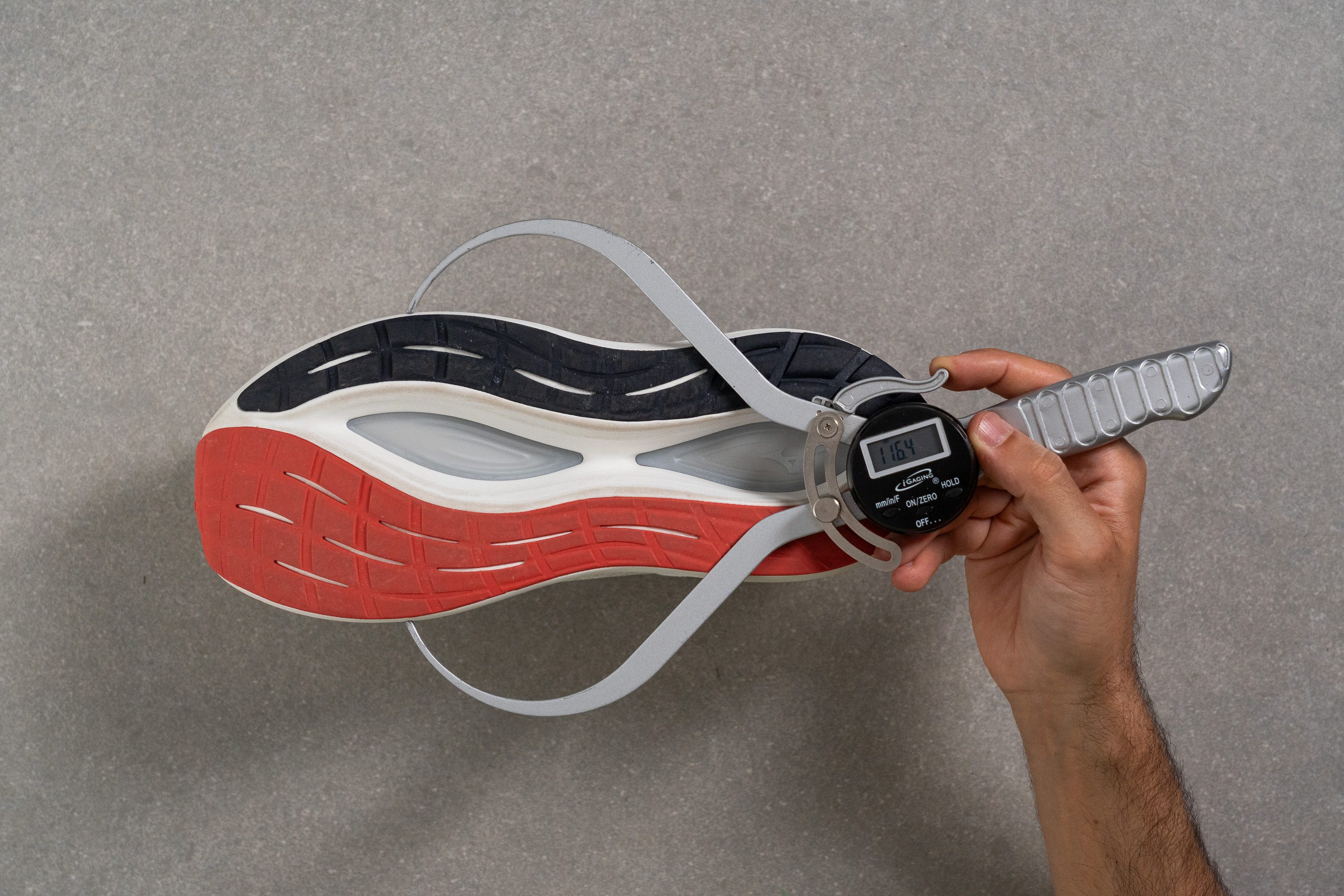
| Neo Vista 2 | 116.4 mm |
| Average | 114.4 mm |
Midsole width - heel
The heel gets the same treatment, shrinking from 97.9 mm to 95.8 mm. Even so, it remains much wider than the average shoe, a necessary adjustment to provide some baseline stability given the Neo Vista 2’s towering stack height.
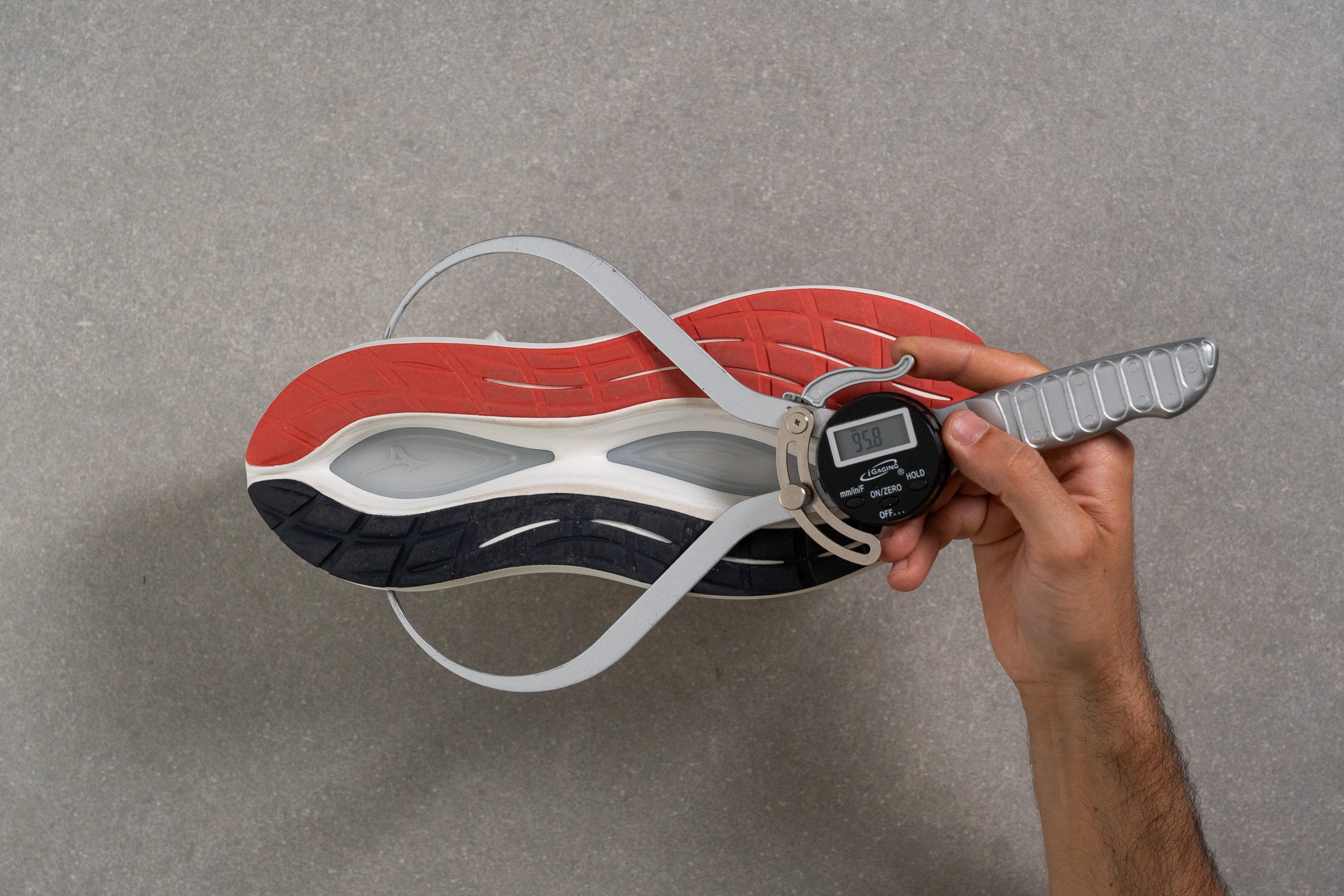
| Neo Vista 2 | 95.8 mm |
| Average | 90.7 mm |
Durability
Toebox durability
The knit material used by Mizuno showed outstanding durability in our Dremel test, earning a top score of 5/5. Combined with the tall-toebox design, we expect it’ll be extremely rare for runners to wear through this area.
| Neo Vista 2 | 5 |
| Average | 2.6 |
Heel padding durability
The absence of heel padding helps the Neo Vista 2 achieve an impressive 4/5 in our heel padding durability test—easily outperforming the average shoe in this category.
| Neo Vista 2 | 4 |
| Average | 3.4 |
Outsole durability
We fired up the Dremel again in the lab to test the toughness of the X10 rubber, and it turns out this Japanese compound is impressively resilient. Only 0.6 mm was worn away!
| Neo Vista 2 | 0.6 mm |
| Average | 1.1 mm |
Outsole thickness
The Neo Vista 2 has 3.5 mm of X10 rubber in the heel, offering excellent protection in this area and making it clear that the shoe won’t let you down with early wear... even if you’re an extreme heel striker.
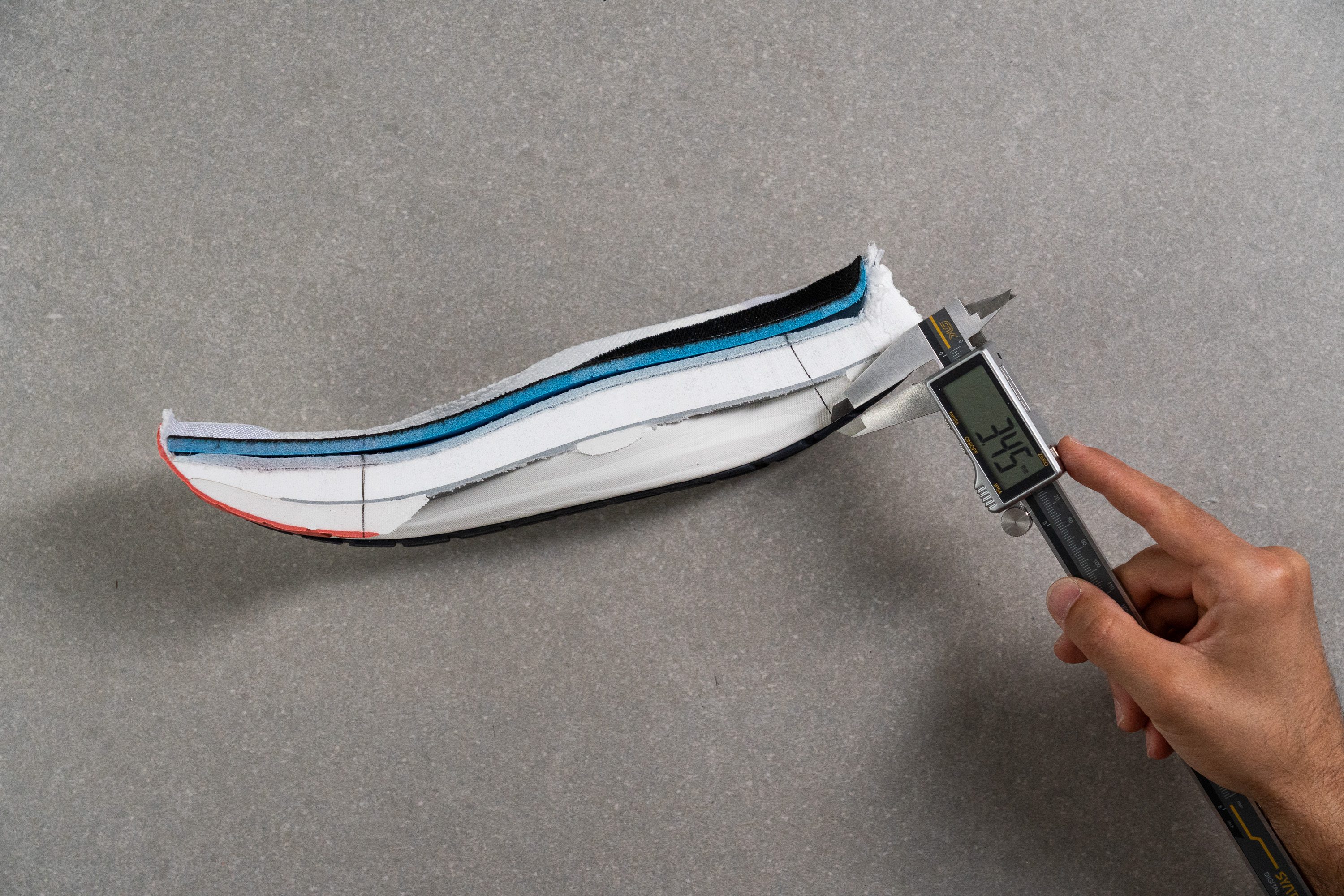
| Neo Vista 2 | 3.5 mm |
| Average | 3.2 mm |
Outsole thickness (forefoot)
Normally, the difference in rubber thickness from heel to forefoot is minimal in most running shoes, but not in the Neo Vista 2.
Mizuno used just 1.70 mm up front, which is an interesting strategy to save weight. And even with this thinner layer up front, we think the X10 rubber will hold up well based on our Dremel test results.
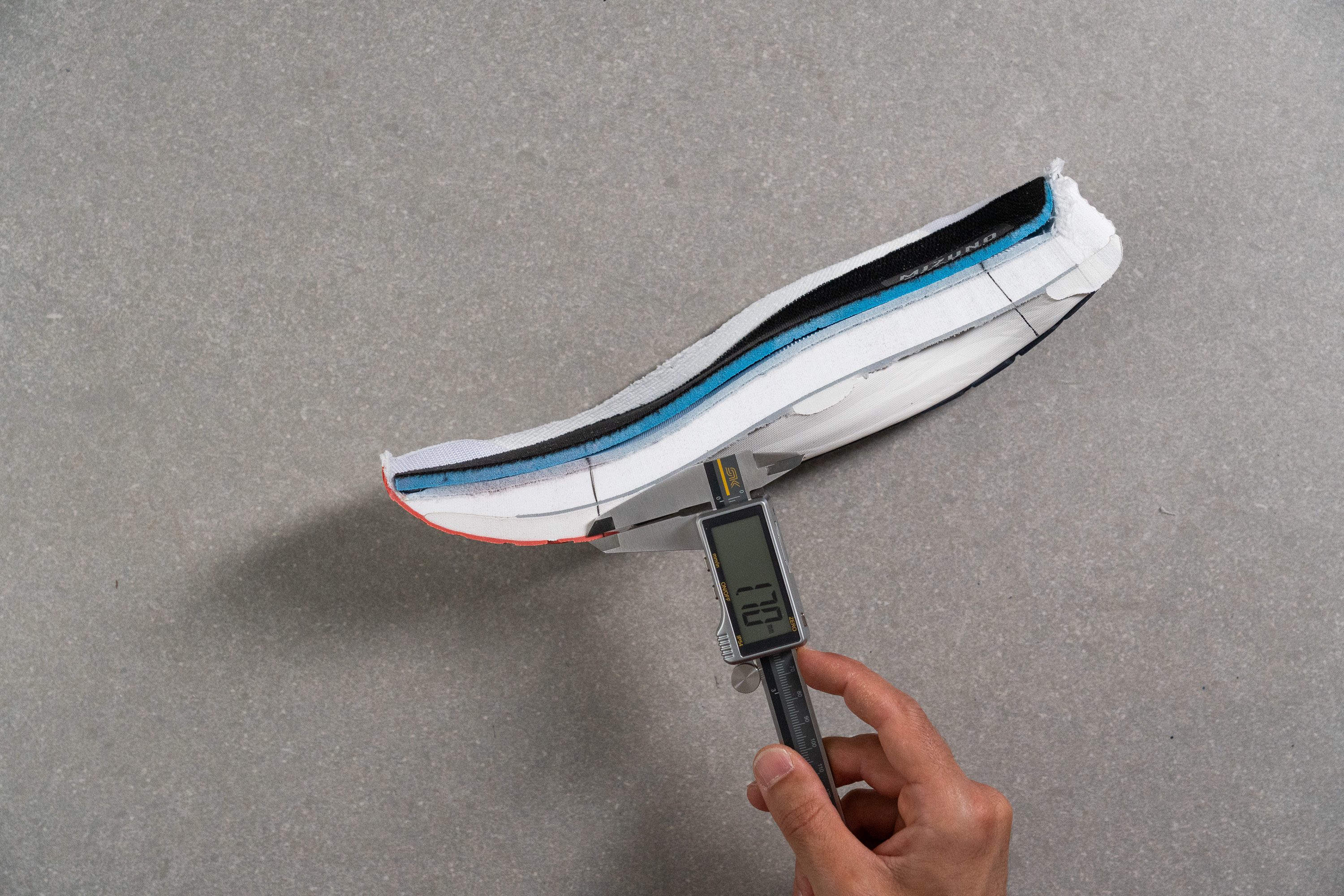
Misc
Insole thickness
The insole adds 4.8 mm of cushioning to the midsole, which is around the average, and it's one of the few areas where the Neo Vista 2 doesn’t stand out.
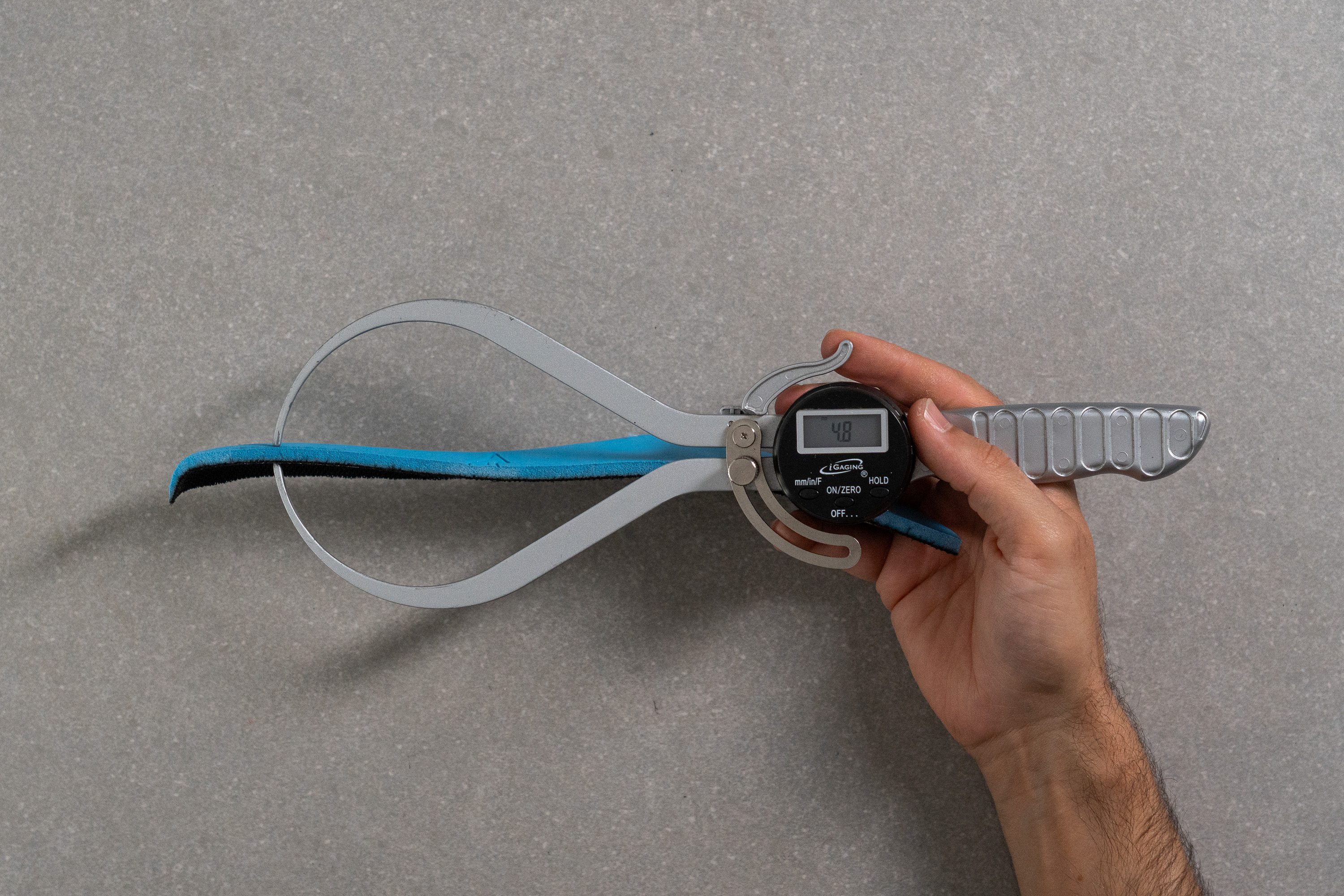
| Neo Vista 2 | 4.8 mm |
| Average | 4.5 mm |
Removable insole
The insole is fully removable, so if you want to swap it for something else like a custom orthotic, you can definitely give it a try.

| Neo Vista 2 | Yes |
Midsole softness in cold (%)
We put the Neo Vista 2 in the freezer for 20 minutes, and it only became 13% firmer. That’s a great result, showing it stays plush and comfortable even in cold winter conditions.

| Neo Vista 2 | 13% |
| Average | 24% |
Reflective elements
Some brands skip reflective details even on their premium shoes, and we’re glad Mizuno isn’t one of them. Safety matters, and with this long reflective strip, cars will definitely spot you from behind.
| Neo Vista 2 | Yes |
Tongue padding
Like most knit uppers, the tongue lacks padding and relies entirely on the thickness of the material. But since sock-like shoes don’t require aggressive lace cinching, this shouldn’t be an issue.
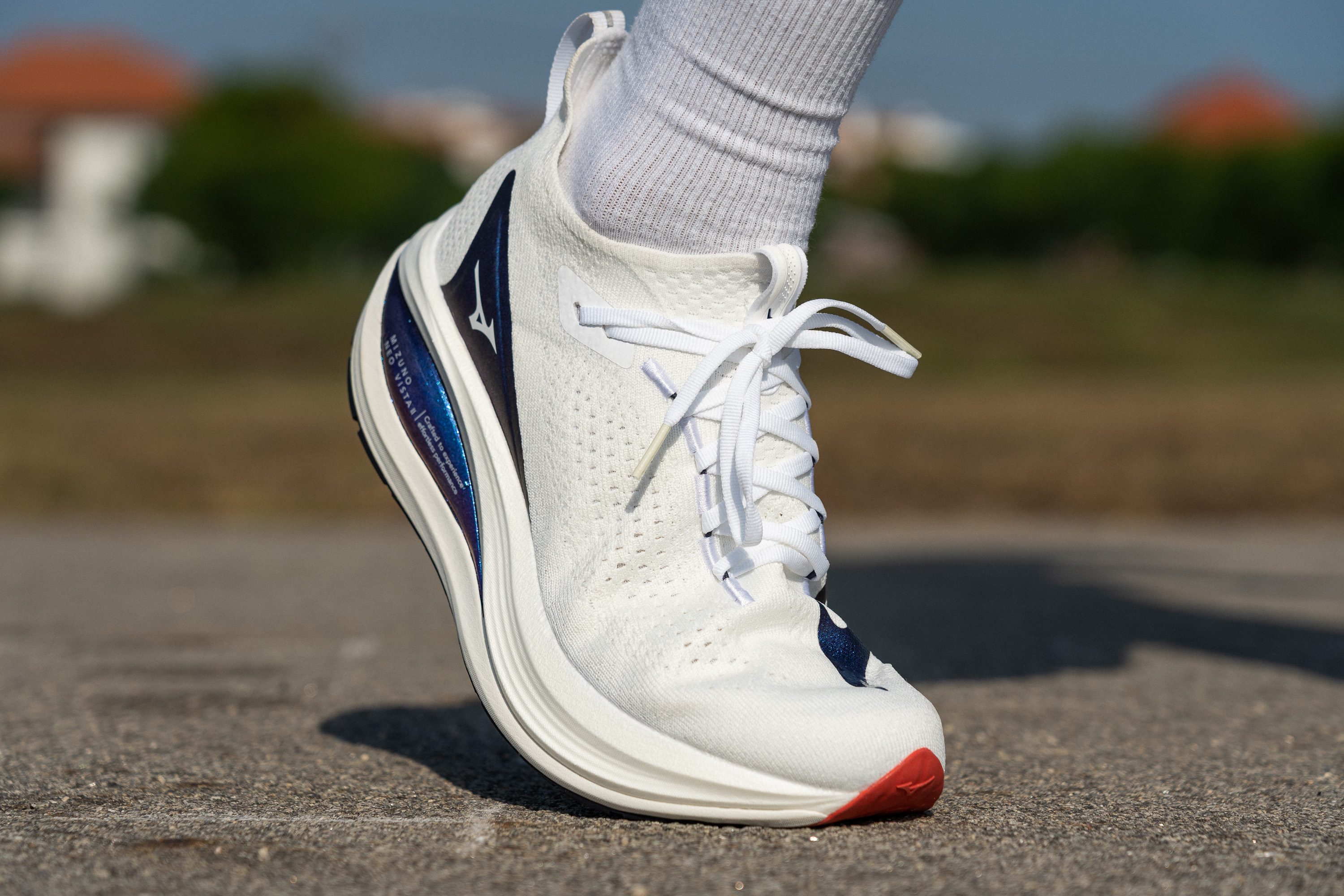
We also found a flat lace setup integrated directly into the knit, using reinforced stitched eyelets. Rather than traditional holes, the laces pass through fabric channels to reduce pressure points—except at the two top eyelets.
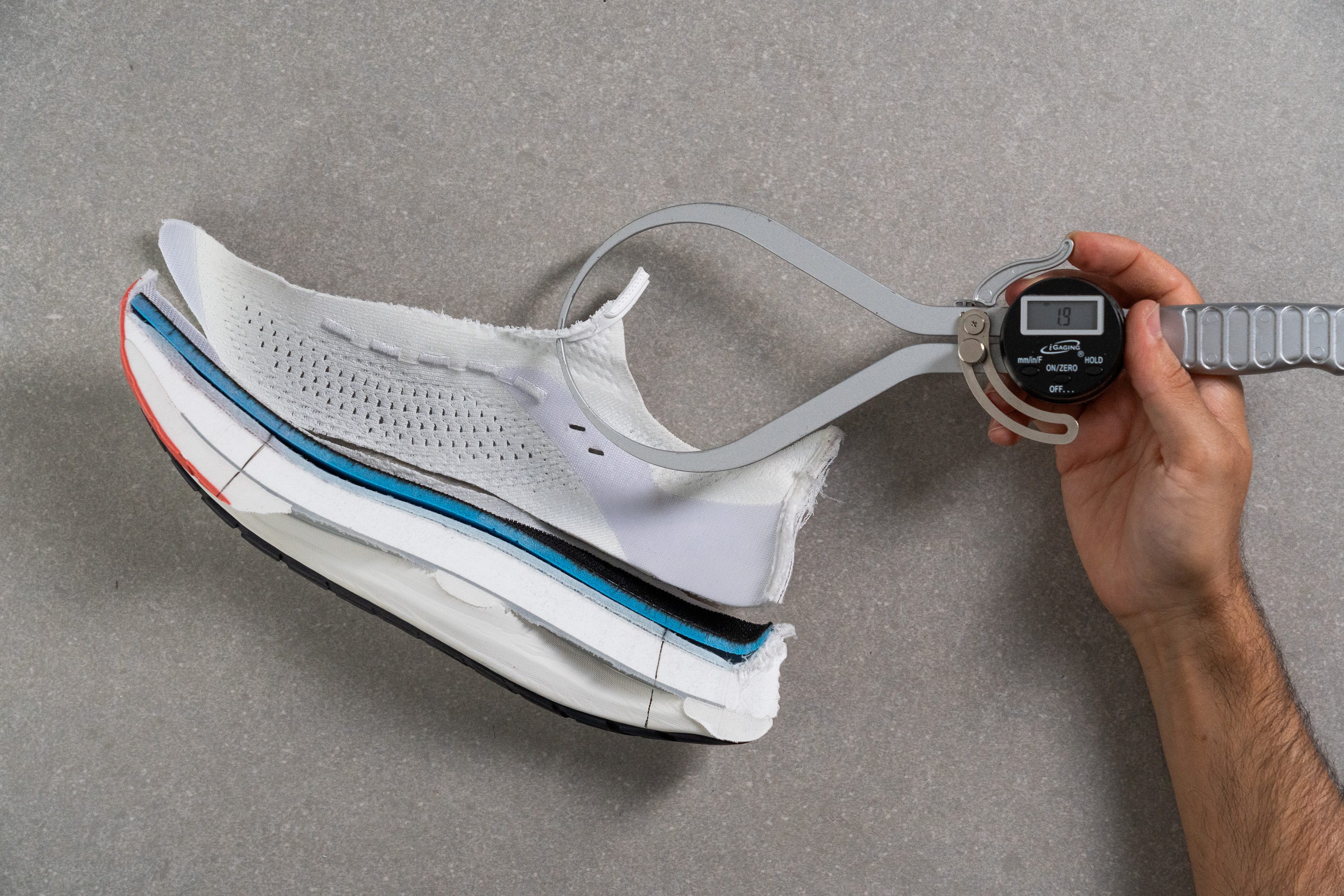
| Neo Vista 2 | 1.9 mm |
| Average | 5.8 mm |
Tongue: gusset type
The sock-like tongue offers an excellent fit and completely eliminates any chance of tongue shifting. However, not everyone loves this type of upper, as certain foot shapes don’t work well with knit shoes. But for us, it fits incredibly well, very similar to the Nike Alphafly 3.
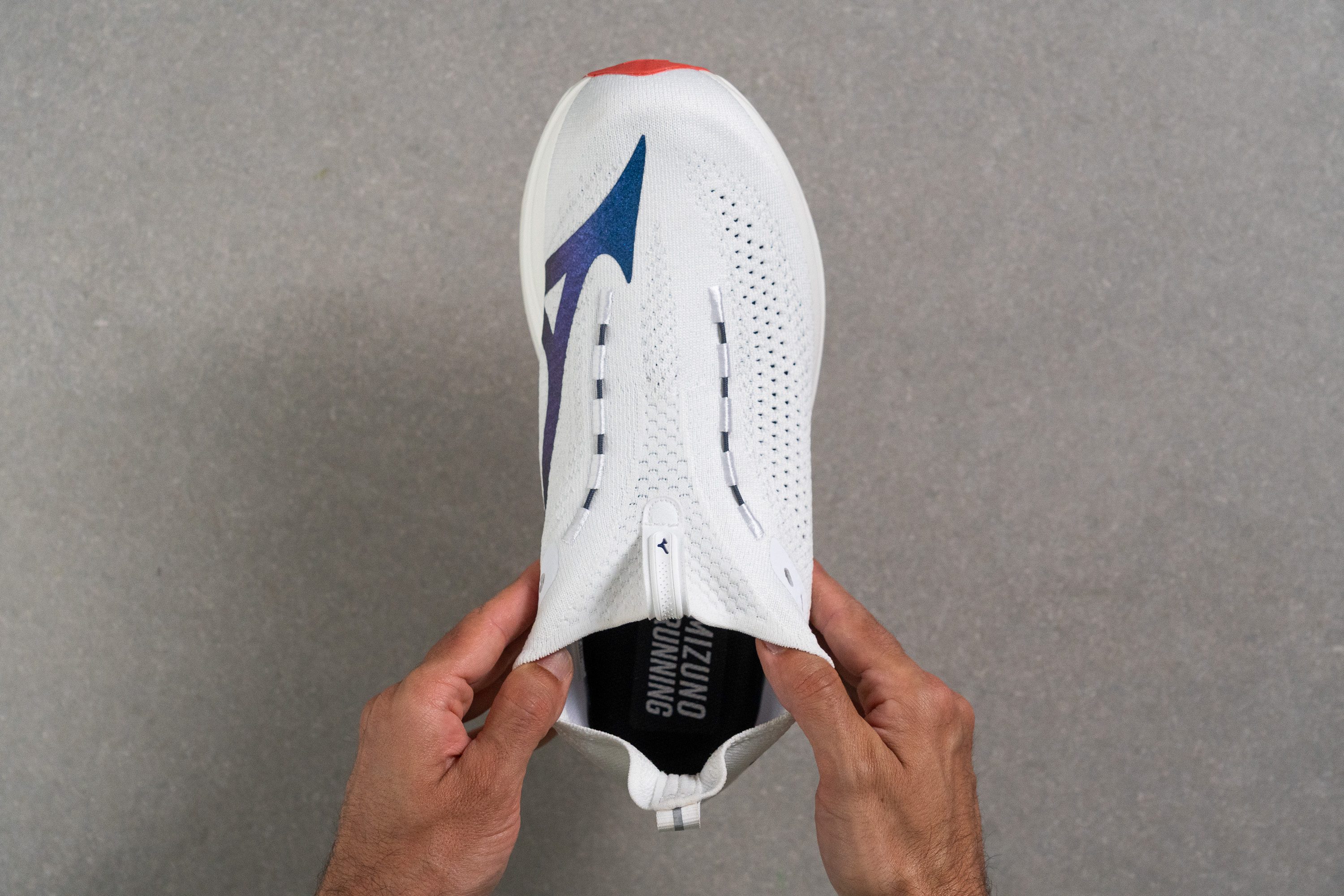
| Neo Vista 2 | Sock like |
Price
We hate price hikes as much as you do, so here’s the bad news: the Neo Vista 2 comes with a 10% increase over the previous model.
Sure, there’s more and (slightly) better foam, plus small improvements throughout. And to be fair, it delivers record-breaking shock absorption, so it’s probably still a fair deal. But any jump in price feels more bitter than sweet, doesn’t it?
| Neo Vista 2 | $200 |
| Average | $152 |
Heel tab
The heel features a finger-loop tab that’s essential due to the knit upper, as pulling it makes it much easier to slide the foot into the shoe. And it looks rad!
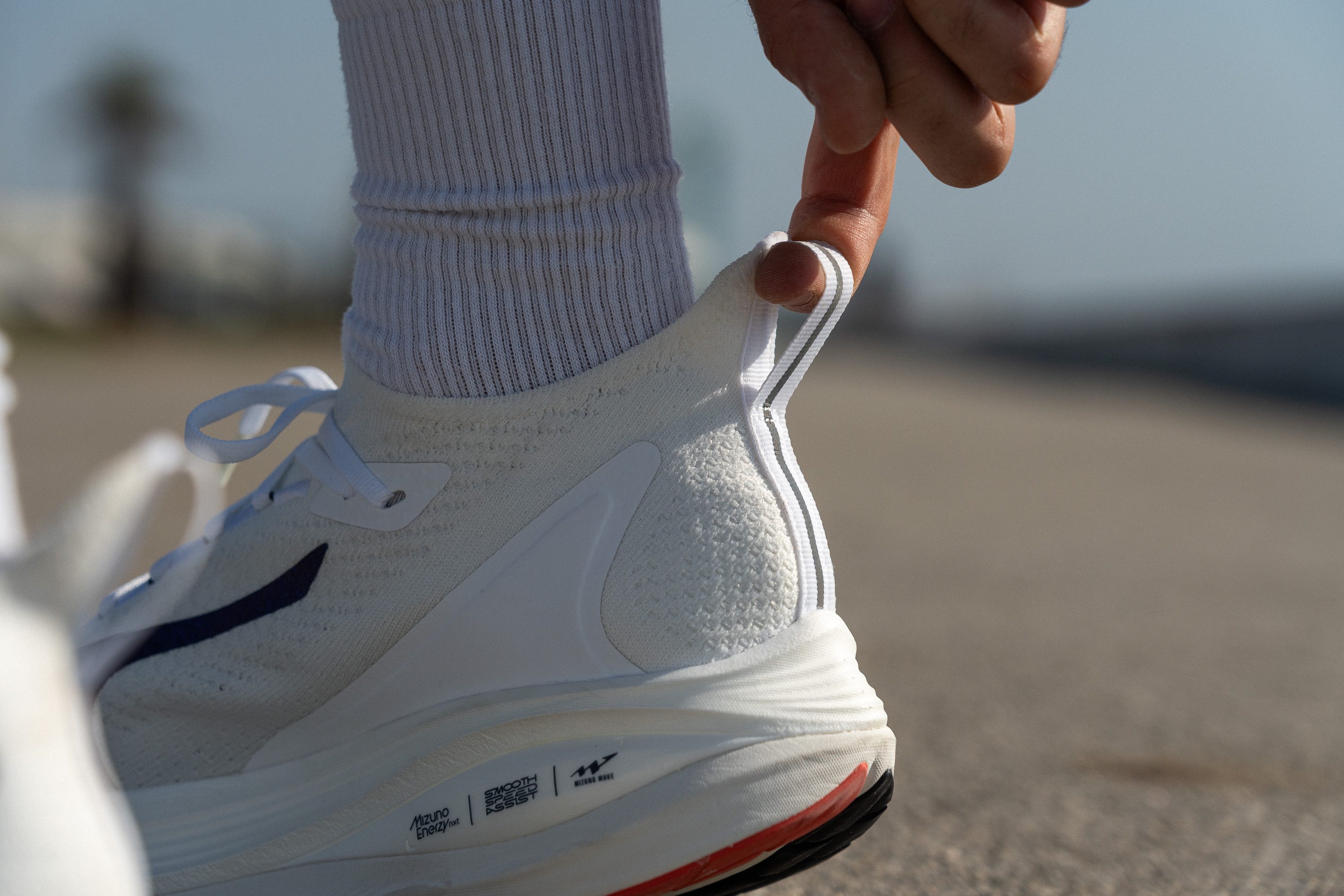
| Neo Vista 2 | Finger loop |
Tongue tab
There’s another finger-loop tab on the shoe, this time on the integrated tongue. It’s a design seen in other shoes like the Nike Alphafly 2 or the ASICS Gel Nimbus 27.
